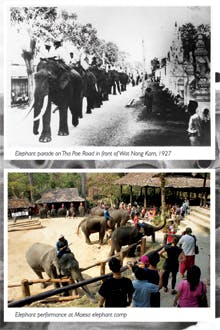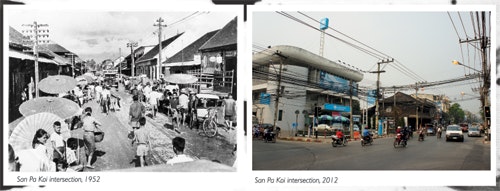
An elephant never forgets
The words ‘Thailand’ and ‘elephants’ are synonymous. Elephants have been revered in Thai culture for hundreds of years. During the 15th century, elephants were used by the Thai army in times of war. They became a saving grace as they were used as a sort of ‘tank’ with tusks. Due to the logging industry’s decimation of Thailand’s forests in the mid- to late-1900s, the elephant population drastically declined from 400,000 to a mere the 7,000 it is today. Although they are still greatly respected and honoured by the older generations, they are becoming less so with the younger population. Where elephants were once thought of as ‘magical’ creatures and treated with great respect, many of them are now seen solely as tourist attractions and have been turned into street begging elephants in the concrete jungles of Thailand’s cities. Although the government has made this practice illegal, the fines are minimal and many authorities choose to turn a blind eye to the problem. This is quite a sobering reality considering these animals were once cherished and thought to be ‘fit for a king’; however, all hope is not lost. Several elephant camps around Chiang Mai are trying to reverse the current situation and provide safe havens for these gentle giants. The Thai Elephant Conservation Centre (www.thailandelephant.org) has even created a mobile elephant clinic that has treated about 40% of the Thai elephant population since it’s opening in 1999. In the past, many elephants were not able to receive proper medical care – transporting an elephant across Thailand is no easy task. Supported by several government agencies, the MEC travels over 70,000 km a year to treat elephants for wounds, illnesses, and preventative care. During their travels, they also provide the mahouts with important health care information. Although elephants are not as respected in Thai culture as they once were, there are still a few people out there who are trying to reverse this trend and preserve the elephants’ rich history in Thailand.
The Walking Street Economy
Influenced by the success of the street market on Silom Road in Bangkok, the Chiang Mai Walking Street market opened in 2002, to encourage tourism, stimulate the economy and promote the production of handicrafts. The council wanted to develop the community as a centre of art, artists, performances and music, making the market a source of cultural tourism. The market immediately gained immense popularity with locals and tourists alike, and has become a constantly expanding, thriving market. In 2004 the market was moved from Tha Pae Road to its present location on Rachadamnoen Road, it now holds around 3000 stalls each Sunday covering an area of 1.5 kilometres. Over the 10 years the market has been open the number of tourists has increased tenfold, with an estimated 50,000 to 100,000 visitors per Sunday, international tourists are numbered around 10%. It is said the market creates a minimum revenue of 9 million baht each week. The head of the Walking Street market from Chiang Mai municipality told
Citylife each stall holder makes on average approximately 3000 baht per Sunday, it is free to set up a stall at the market, however prospective stall holders must go on a waiting list first as competition for spaces is high. The fame of the market is certain to ensure its survival, however it is evident that not all products in the market are locally made, and not all performers are local, as was originally intended. The market also causes a headache for many Sunday drivers and can get quite over crowded. However all said, the Walking Street market is now well engrained into the character of Chiang Mai and should remain an inseparable element to such a vibrant city.

Satellite Cities
In 2000 it was noted that the urban area of Chiang Mai increased from 15 km2 in 1952 to 339 km2, 12 years on the city continues to expand and swallow surrounding territory. During times of economic and population growth Chiang Mai has undergone rapid land cover and land use changes, in particularly urban and suburban/industrial land is sharply increasing. Since rapid development in Thailand from the 1980s onwards much land previously agriculturally productive or uninhabited has been converted to residential and industrial land. Today Chiang Mai is a matted mesh of merged towns and villages created by an increase in infrastructure connecting once outskirt areas together. Over the last three decades the valley of Mae Nam Ping basin around Chiang Mai has been drastically changed. The increase of new housing estates has changed the landscape of Chiang Mai.

Change for Rincome
This black and white image of Rincome intersection is a far cry from the current condition of the slaving cross roads. Ever sat in three lane traffic at one of the traffic lights waiting for what seems like an eternity for the light to turn green? – I thought so. This time spent frustratingly waiting in the heat and dust of Chiang Mai’s road network is hardly surprising due to the vast development the city has undergone. A new development, part of the continual great flux of change, is soon to be seen at this famous Chiang Mai intersection. Apart from the closing of Amari Rincome hotel, now boarded off with rumours of a new shopping complex being built, though no-one would talk to us about the details of this project, another couple of new developments will become apparent on the opposite side of Nimmanhemin road. Going by the name of ‘Think Park’ a new ‘community mall’ will commence construction in the next few months and is planned to open by the end of the year. Covering an area of 2 rai, the new complex, which has been compared to Palio Khao Yai in Nakhon Ratchasima a pastiche Italian village, is said to be an area for art lovers and a trendy new place to hang out in Chiang Mai. The mall will house up to 70 shops selling arts, crafts and handmade products, there will also be an art exhibition area. In addition, a condominium with 80 living spaces and hotel will adjoin the mall. The 400 million baht funding for this new development comes from the self-made billionaire Tan Passakornnatee, the previous owner of Oishi green tea company, who now has interests in land and property development. Tan’s daughter Varisa, a theatre design graduate, will head the project under Tan Boon Co. Adding to Tan’s mini monopoly in this area Tan has invested 300 million baht to create a ‘city mall’ called ‘S-One’. This latest venture will be located next to Dalaat Rincome, on the superhighway road side diagonal from the old Amari. On the 9 rai plot, ‘S-One’ will comprise of an entertainment complex with restaurants, shopping outlets and a cinema. While we anticipate the arrival of these new additions to Chiang Mai, we are very concerned about traffic problems and will try to do a follow up on this story when we know more.
Hotel History
It’s hard to imagine Chiang Mai without the smattering of hotels that now occupy almost every block in the city. Before 1921, however, there were none. Then came the Terminus Hotel, Chiang Mai’s first accommodation built for tourists, which was founded by Queen Rama VII. Even though the opening of new hotels seems like somewhat of a daily occurrence these days, some hotels have become part of Chiang Mai’s deep history. For example, The Sriprakard Hotel was opened by the first mayor of Chiang Mai, Luang Sriprakard. A short time later, a group of hill tribe people began to sell things in front of the hotel on Chang Klan Road. Little did they know, many years later, this tradition would carry on in what we now know as the famed Night Bazaar.
Some of Chiang Mai’s hotels are more famous than others. The Chiang Mai Orchid (then Hyatt), for example, housed the likes of Lady Diana and Prince Charles and Prince Chow and Rkihito (the Prince of Japan) during what was called ‘Visit Thailand Year’ in 1989. The Orchid was also used as one of the locations in the film ‘Rambo’ as well as being Mel Gibson’s stomping ground during the filming of ‘Air America’. Chiang Mai is home to some of the best luxury resorts in Thailand. Travel + Leisure Magazine has recognised The Mandarin Oriental Dhara Dhevi and The Four Seasons Resort as being among the best in the world, recently awarding them the No. 1 and No. 4 spots respectively.
Whether you see it as a blessing or a curse, the arrival of the first hotel in 1921 was the first step in Chiang Mai’s long journey to becoming one of Thailand’s great tourist destinations. Over 90 years later, Chiang Mai now has over 41,000 rooms for rent. Hard to believe the opening of one small hotel would start a trend that would so drastically change the landscape of Chiang Mai forever.
